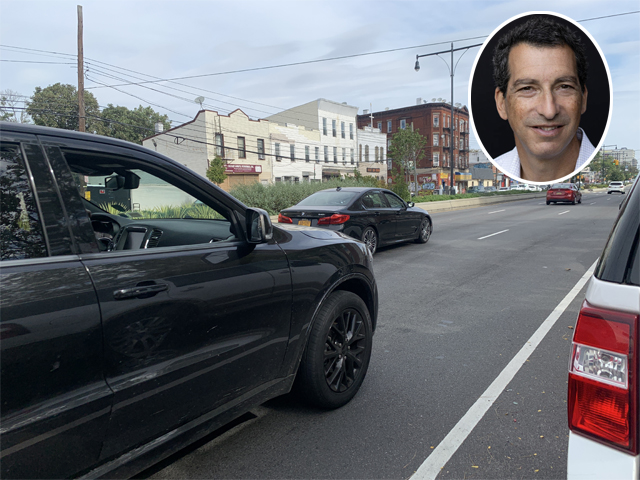Opinion: DOT’s Traffic Engineering Division is Hostile to Street Safety

On Tuesday, the City Council will have an oversight hearing to examine the success of Mayor de Blasio’s Vision Zero initiative. To watch the 10 a.m. hearing, click here. Streetsblog Publisher Mark Gorton offers his perspective on one major failure: how Department of Transportation engineers define their mission.
The Department of Transportation has difficulty producing safe street designs because it continues to be dominated by a regressive core of traffic engineers that prioritizes traffic flow over safety. As a result, the agency does not preemptively redesign dangerous roads, but only does so due to public outrage after a high-profile road death. Safety improvements should not have to be hard fought. New York City needs to move beyond fixing individual streets towards reforming the system which produces unsafe streets as its default.
The most recent example of how DOT puts car drivers first came last week, when Jose Ramos, a deaf resident of East New York, was killed by a speeding driver on Atlantic Avenue. As Gersh Kuntzman pointed out in Streetsblog, traffic engineers at DOT sabotaged one of Mayor de Blasio’s first Vision Zero projects in 2014, turning the mayor’s stated desire to make Atlantic Avenue safer into a bloated $47-million project that added some plantings, but intentionally did not make the roadway safer or reduce its “level of service” for drivers. These are the same engineers that have been quietly undermining safety projects for decades.
The engineering methodology that allows for meat grinders like Atlantic Avenue to be built starts with “design constraints” that determine how many cars “need” to be moved through a particular street. By starting with traffic flow, the traffic engineers have developed a methodology that specifically excludes the inevitable human cost of their designs. The concept of desired throughput needs to be banned from use at DOT. Roads cannot and should not be pushed to accommodate more traffic than can be done safely.
When the basic nature of the interaction between delicate human beings and big chunks of steel are included in engineering calculations, the need to slow and minimize traffic follows naturally. Any other conclusion accepts that human life is disposable and that innocent deaths are acceptable. Politicians have said that our children are not roadkill, but traffic engineers at DOT still practice in a bubble of denial that is maiming and killing our neighbors and loved ones. As the Streetsblog story showed, the engineers who signed off on the Atlantic Avenue beautification repairs knew that by maintaining three highway-like lanes, they were consigning about 150 people every year to injury and death — the same numbers as before they spruced up Atlantic Avenue with cosmetic improvements that did not reduce the roadway’s danger.
Eight years of the mayor demanding Vision Zero has not forced the traffic engineers to change. The DOT’s mission statement and leadership repeatedly talk about prioritizing safety, yet still the engineers disregard them and continue to fight their misguided crusade to blindly force traffic through our neighborhoods.
The traffic engineering division needs to move beyond its 1950s level of service methodologies to a Vision Zero engineering framework that properly incorporates the needs and vulnerabilities of all road users into all road designs. This holistic framework is the exact opposite of traffic flow oriented engineering as it is currently practiced at DOT. Outside talent familiar with modern European traffic engineering methodologies should be brought in to oversee this turnaround.
The traffic engineers at DOT have been enormously resistant to change, so outside overseers will need to be involved to ensure that they cannot continue to stonewall progress. The City Council should hold hearings on this specific topic, and the DOT Commissioner should make reforming this unit a top priority.
Traffic engineers do have necessary technical and drafting skills and knowledge to translate design ideas into construction plans. Concepts like signal timing, road curvature, planning for drainage, and many other civil engineering concepts are important, and this body of knowledge within DOT should be retained. However, none of these skills is useful for determining what sorts of streets the city needs, and the traffic engineering division should be removed from policy making. The leadership at DOT needs to make it clear to the organization that the current engineering certifications used as tools of authority by the engineering staff are being wielded improperly.
With a reformed engineering unit, safer street redesigns will no longer be a fight. Modern street design techniques that have been standard in Europe for decades can be adopted quickly and not grudgingly and slowly. Remaking thousands of miles of streets and thousands of intersections will be a giant task. Even with a high performing, modern engineering unit at DOT, this work will take decades, but a proper makeover of the traffic engineering profession can prevent hundreds of thousands of injuries in the coming years.
Mark Gorton is CEO of Open Plans, the livable streets organization, and Publisher of Streetsblog.





